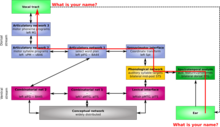Two-streams hypothesis
[1] The hypothesis, given its initial characterisation in a paper by David Milner and Melvyn A. Goodale in 1992, argues that humans possess two distinct visual systems.The dorsal stream (or, "where pathway") leads to the parietal lobe, which is involved with processing the object's spatial location relative to the viewer and with speech repetition.[6] In 1982, Ungerleider and Mishkin distinguished the dorsal and ventral streams, as processing spatial and visual features respectively, from their lesion studies of monkeys – proposing the original where vs what distinction.Visual action planning and coordination, on the other hand, uses absolute metrics determined via egocentric frames of reference, computing the actual properties of objects relative to the observer.Damage to the posterior parietal cortex causes a number of spatial disorders including: The ventral stream is associated with object recognition and form representation.This is evident because its ability to acquire new vocabulary, be disrupted by lesions and auditory feedback on speech production, articulatory decline in late-onset deafness and the non-phonological residue of Wernicke's aphasia; deficient self-monitoring.The articulatory network 1, which processes motor syllable programs, is located in the left posterior inferior temporal gyrus and Brodmann's area 44 (pIFG-BA44).Contemporary perspectives however, informed by empirical work over the past two decades, offer a more complex account than a simple separation of function into two-streams.[29] Recent experimental work for instance has challenged these findings, and has suggested that the apparent dissociation between the effects of illusions on perception and action is due to differences in attention, task demands, and other confounds.[30][31] There are other empirical findings, however, that cannot be so easily dismissed which provide strong support for the idea that skilled actions such as grasping are not affected by pictorial illusions.Thus the emerging perspective within neuropsychology and neurophysiology is that, whilst a two-systems framework was a necessary advance to stimulate study of the highly complex and differentiated functions of the two neural pathways; the reality is more likely to involve considerable interaction between vision-for-action and vision-for-perception.Robert McIntosh and Thomas Schenk summarize this position as follows: We should view the model not as a formal hypothesis, but as a set of heuristics to guide experiment and theory.The differing informational requirements of visual recognition and action guidance still offer a compelling explanation for the broad relative specializations of dorsal and ventral streams.

visionhearingMelvyn A. Goodaleauditory systemsoccipital lobephonologicalrecognitionblindsightWeiskrantzUngerleiderMishkinpatient D.F.motor planningprimary visual cortexposterior parietal cortextemporal lobesaccadesSimultanagnosiaHemispatial neglectAkinetopsiaApraxiamedial temporal lobelong-term memorieslimbic systemparvocellularmagnocellularlateral geniculate nucleusthalamusneuronsreceptive fieldsattentionworking memorysaliencerecognize facesventral auditory pathwaydorsal pathwayinferior temporal gyrusConduction aphasiaarcuate fasciculusvisual agnosiaoptic ataxiaLanguage processing in the brainVision for perception and vision for actionVisual memoryVisual cortexVisual systemMagnocellular cellTectopulvinar pathwayAuditory systemObject recognition (cognitive science)Medial superior temporal areaLateral pulvinar nucleusPulvinar nucleiPhantom contourParasol cellConstructional apraxiaKoniocellular cellBibcode